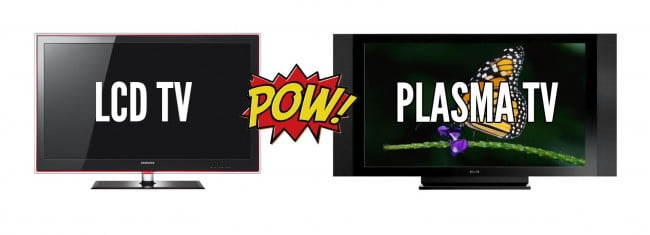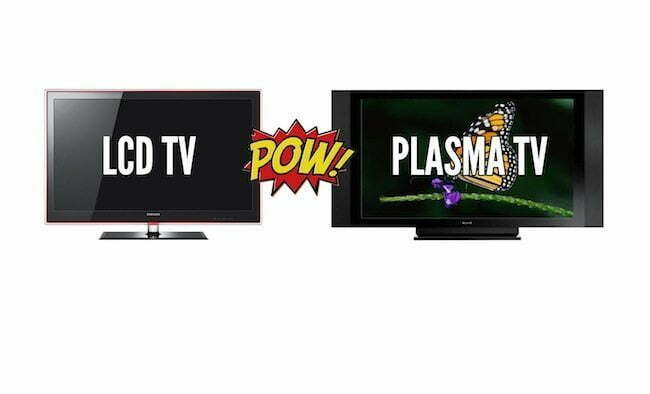
When shopping for a new HDTV, you may wonder which should you get, LCD or Plasma? It’s really a good question and is often subject to almost a religious debate amoungst videophiles. But the reality of it is, that it largely depends on where the TV is going to go. Here’s breakdown of the differences between LCD and Plasma and what you should get for your home. Here’s some more excellent information that you can use – FAQ for choosing an outdoor TV.
Resolution:
When it comes to how sharp either HDTV is, it’s pretty much a wash. Both come in 1080p models so the resolution is about the same, depending on what model you get. Additionally, both come in 120hz versions (meaning 120 frames go by per second) and LCDs actually go up to 240 and even 480 in some high end models. The down side here is that you end up with the “soap opera” effect of a plastic like look with a higher resolution TV – especially when most broadcast programs are sent at 60hz.
Color and Contrast:
Here’s where plasma can really shine. Plasmas offer richer, bolder colors – especially with blacks, which look really dark and make scenes that are in shadow highly detailed. LCDs that have back lit LEDs and local dimming are closing the gap here, but plasma still has the edge, especially with conventional LCDs that use edge-lit LEDs or florescent light, which can make for a pretty contrasty display.
Off angle viewing
Plasma offers a nice bright and vibrant picture from any angle that is off axis, while some viewing LCDs off axis (especially 3D) may find a slightly dimmer picture.
Reflectivity
This where room location is key. Plasmas have highly reflective surfaces and as such, are generally better in home theater rooms that have either no windows or where the room can be completely darkened. If you have a living room or den with bright, ambient light, then and LCD is your best bet since most models opt for a matte finish display.
Power consumption
LCDs have the lead here, especially LEDs which are very stingy when it comes to power. Plasma, by contrast, are power hogs and will definitely put a dent in your monthly electric bill. As time goes on, though, plasma manufacturers are working to improve power consumption levels – they have to since states like California have mandated it by law. But in the short run, LCDs use far less electricty than their plasma cousins.
Life Span
Both LCDs and Plasma are generally rated at 60,000 hours, or about 20 years if used 8 hours per day. But some plasmas, have been experiencing a phenomenon where after only a few thousand hours the screen amps up the brightness of black levels which could cut the lifespan short. Panasonic has acknowledged the issue and is working to solve the problem with a potential firmware fix. Plasmas also need a break in time of about 100 hours where only full screen viewing should be done, and in movie or cinema modes. This prevents the plasmas phosphors from being overly stimulated by the dynamic brightness settings which could impact it’s lifespan. And widescreen or letterboxed programming need to be avoided in those first 100 hours to avoid prematurely affecting the phosphors with black stripes as well. Digital Video Essentials (not the Blu-ray) has a great pattern that’s a solid, full white field of noise which will exercise all the pixel phosphors the same. Also, there’s a Plasma TV Logo Removing DVD, available in NTSC or PAL format. You can get it at beginwithsoftware.com. It puts colored noise on screen.
What about burn-in complaints on plasma? That was a problem with early models which would have those station logos (called bugs) burned into the corners since they are always on. But plasma makers have virtually eliminated that issue although it could manifest itself if the TV is on 24/7.
3D
You can find 3D capable HDTVs in both Plasma and LCD. In fact, many experts – including Walt Mossberg and Scott Wilkinson, are of the mind that 3D TVs are the best 2D TVs on the market. And as time goes on, 3D is going to become just another available feature. The real question is, active or passive. And generally, passive is far cheaper than active. And if you like to entertain, using passive 3D glasses will impact your wallet far easier than active – where you must have the same glasses for each person viewing.
Price
Because LCDs are more popular and available, they tend to be less expensive than plasma TVs. Additionally, only two or three manufacturers (namely Panasonic and Samsung) actually still make Plasma.
Conclusion
So whether you are looking to get an LCD or Plasma TV, the important thing is to start with where you’re going to put it. If it’s near a bright light source like a window or sliding back door, then LCDs are probably your best bet. If in a darkened room like a den or basement, then plasmas definitely provide a leg up.
Related Articles:

































![Best Drones Under the Cost of Ferrari in [year] 25 Best Drones Under the Cost of Ferrari in 2025](https://www.gadgetreview.dev/wp-content/uploads/image-test-3.jpg)
![Best LEDs & LCDs in [year] ([month] Reviews) 26 Best LEDs & LCDs in 2025 (December Reviews)](https://www.gadgetreview.dev/wp-content/uploads/Samsung-UN65RU7100FXZA.jpg)
![Best Streaming Services in [year] ([month] Reviews) 27 Best Streaming Services in 2025 (December Reviews)](https://www.gadgetreview.dev/wp-content/uploads/netflix-750x422-1.png)
![Best Streaming Movie and Shows in [year] ([month] Reviews) 28 Best Streaming Movie and Shows in 2025 (December Reviews)](https://www.gadgetreview.dev/wp-content/uploads/Streaming-reviews.jpg)
![Best TVs in [year] ([month] Reviews) 29 Best TVs in 2025 (December Reviews)](https://www.gadgetreview.dev/wp-content/uploads/Sony-XBR55X810C-TV-1.jpg)
![Best Shows on Amazon in [year] ([month] Reviews) 30 Best Shows on Amazon in 2025 (December Reviews)](https://www.gadgetreview.dev/wp-content/uploads/The-Boys-750x474-1.jpg)
![Best Small TVs in [year] 31 Best Small TVs in 2025](https://www.gadgetreview.dev/wp-content/uploads/best-small-tv-image.jpg)
![Best 60 Inch TVs in [year] 32 Best 60 Inch TVs in 2025](https://www.gadgetreview.dev/wp-content/uploads/best-60-inch-tv-image.jpg)
![Best 50 Inch TVs in [year] 33 Best 50 Inch TVs in 2025](https://www.gadgetreview.dev/wp-content/uploads/best-50-inch-tv-imgr.jpg)
![Most Energy Efficient TVs in [year] 34 Most Energy Efficient TVs in 2025](https://www.gadgetreview.dev/wp-content/uploads/most-energy-efficient-tv-image.jpg)
![Best TVs for Apple TV in [year] 35 Best TVs for Apple TV in 2025](https://www.gadgetreview.dev/wp-content/uploads/best-tv-for-apple-tv-image.jpg)
![Best TV Antennas in [year] ([month] Reviews) 36 Best TV Antennas in 2025 (December Reviews)](https://www.gadgetreview.dev/wp-content/uploads/best-tv-antennas-image.jpg)
![Best Mitsubishi TVs in [year] 37 Best Mitsubishi TVs in 2025](https://www.gadgetreview.dev/wp-content/uploads/best-mitsubishi-tv-image.jpg)
![Best Smart TVs in [year] ([month] Reviews) 38 Best Smart TVs in 2025 (December Reviews)](https://www.gadgetreview.dev/wp-content/uploads/best-smart-tvs-image.jpg)
![Best Conference Room TVs in [year] 39 Best Conference Room TVs in 2025](https://www.gadgetreview.dev/wp-content/uploads/best-conference-room-tv-image.jpg)
![Best Dumb TVs in [year] 40 Best Dumb TVs in 2025](https://www.gadgetreview.dev/wp-content/uploads/best-dumb-tv-image.jpg)
![Best 80 inch TVs in [year] 41 Best 80 inch TVs in 2025](https://www.gadgetreview.dev/wp-content/uploads/best-80-inch-tv-image.jpg)
![Best Shows on Hulu in [year] ([month] Reviews) 42 Best Shows on Hulu in 2025 (December Reviews)](https://www.gadgetreview.dev/wp-content/uploads/The-Handmaids-Tale-750x422-1.jpg)

















